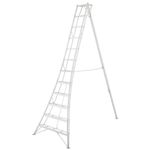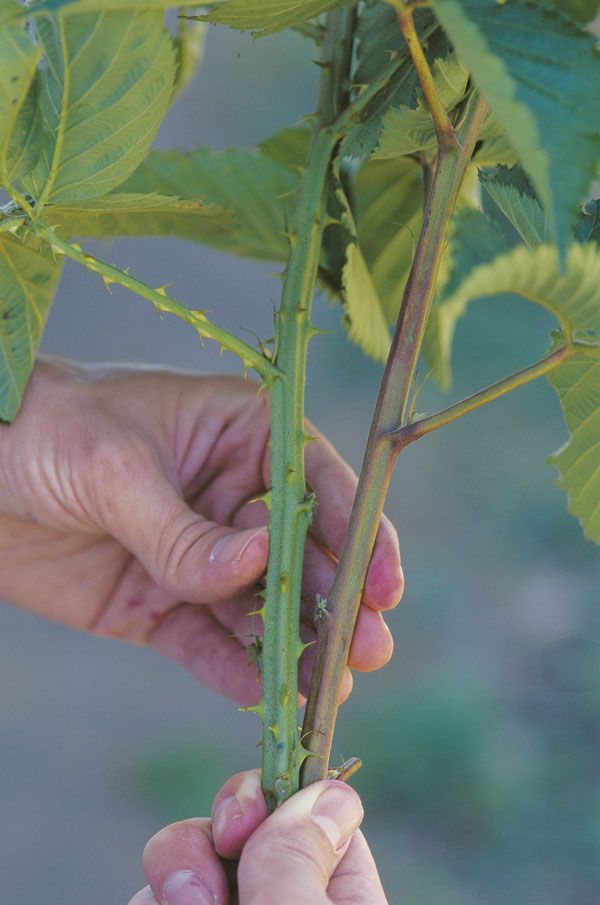
by John R. Clark
June 1999
from issue #21
Blackberries. The mere mention brings several thoughts to mind, including blackberry cobbler, ticks, chiggers, and snakes. When I was growing up in the South, the annual blackberry harvest from thorny plants growing on fence rows, pond dams, and forest clearings was both a pleasure and a curse. The occasional encounter with eight-legged and reptilian friends always enhanced the experience. But with the improved varieties available these days, you can have easy-to-pick fruit and a minimum of tangling with thorns and wildlife. Your main concern is likely to be what kind of ice cream to have with the berries.
Upright varieties are less work
 |
|
| Traditionally, blackberries are floppy-caned ramblers, but a select group grows erect. Some, like the one pictured here, are even thornless. | |
Blackberries are usually grouped according to growth habit. Trailing and semi-erect plants require trellising. Erect-caned plants generally don’t need support, although in some cases—if they’re planted in a windy spot, or there’s a huge crop, or they haven’t been pruned enough—temporary support may be needed. But erect varieties don’t need permanent trellising. There are other advantages as well: The berries are easier to pick, they don’t get splashed with soil when it rains, and you can mow around them.
I lead the blackberry breeding program at the University of Arkansas, where we’ve been focusing on creating new upright varieties. As you might guess, I’m a big fan of upright blackberries. I recommend six such varieties currently available (not all of them from Arkansas). You’ll find details in the chart at the end of this page. If you live in Zones 5 to 8, there’s an upright blackberry you can grow.
The two major considerations in selecting blackberries are flavor and the presence or absence of thorns (two of the six upright varieties are thornless). I can’t think of a better illustration of objective vs. subjective characteristics. Everybody prefers thornless plants, but opinions of flavor vary. I prefer more sweet and less tart; you may think otherwise. All of the uprights have what I consider an eastern U.S. blackberry flavor. Blackberries from the Pacific Northwest, such as ‘Marion’, on the other hand, have a unique flavor due to their very different genetic background.
 |
|
| Wild blackberries (left) are smaller than those produced by upright varieties. With ‘Kiowa’ (above), you’ll be picking huge, tasty berries for six weeks. Big fruit plus a long season make this one of the most productive of the upright blackberries. | |
 |
|
| When you pick berries from thornless canes, you won’t cut your skin to ribbons in the process. | |
In addition to being unarmed, erect, thornless blackberries offer other advantages. First, their fruits generally are firmer than those of thorny types, so they hold up longer in storage. Second, thornless blackberries are less serious about producing new sprouts from the roots, so they’re easier to keep contained. Unfortunately, the thornless upright blackberries currently available aren’t as hardy as some of the thorny ones.
Proper pruning is key
Blackberries are best suited to being grown as a hedgerow; I like to site them along a property line. If you have a problem with unwanted mammalian traffic, a border of thorny blackberries is a great deterrent. A hedgerow that’s 18 inches wide at the base can be kept to near 36 inches wide at the top—narrow enough to reach to the center to harvest every berry. Just don’t plant blackberries too close to other landscape beds since the roots send out new shoots, or suckers, that can be invasive.
Blackberries have a perennial root system, but the canes are biennial, meaning they live for two years. First-year canes, known as primocanes, don’t flower. Second-year canes are called floricanes. They flower in the spring, produce fruit in the summer, and then die. Each year the cycle repeats itself, with primocanes growing at the same time floricanes are fruiting.
With upright blackberries, the key to success is correctly managing the primocanes to produce the “hedgerow” growth habit. Cane management includes pruning both during the growing season and during dormancy. I think of summer pruning as training because it consists largely of trimming the primocanes to control their shape. Training is a simple process that doesn’t take long, but if you don’t do it, your plants will grow leggy and possibly won’t stand upright.
Start training primocanes during the plant’s second year. In their first growing season, the plants should need no pruning because first-year growth of upright blackberries is rather bushy. Erect canes will begin to develop the second year. Two or three times during the growing season, top the primocanes back at a height of 40 to 46 inches. This causes lateral branches to grow from the buds in the leaf axils, and results in more fruit the next season. Primocanes continue to develop and grow during most of the growing season, which is why you must cut them back a few times. This is the only cutting you should do on primocanes during the growing season.
 |
|
Floricanes die after they finish fruiting. Once this happens, you can remove them at any time, cutting them at ground level.
Winter pruning involves removing excess canes and shortening lateral growth. To keep your blackberry hedgerow from getting too wide, cut or dig out any primocane growing outside an 18-inch-wide band at the base of the cane row. Also remove excess primocanes. Three to six canes per foot of row in an 18-inch-wide band is adequate for good yields and large berries. Finally, shorten lateral growth on primocanes to 12 to 18 inches.
| Sources for blackberries Plants are usually shipped bare-root in the dormant season. |
|
| Boston Mountain Nurseries 20189 N. Highway 71 Mountainburg, AR 72946 479-369-2007 www.alcasoft.com/bostonmountainIndiana Berry and Plant Co. 5218 W. 500 S. Huntingburg, IN 47542 800-295-2226 https://indianaberry.comNourse Farms 41 River Road Whately, MA 01093 413-665-2658 www.noursefarms.com |
Simmons Plant Farm 11542 North Highway 71 Mountainburg, AR 72946 479-369-2345 www.simmonsplantfarm.comStark Bro’s PO Box 1800 Louisiana, MO 63353 800-325-4180 www.starkbros.com |
Harvest early and often
You should get your first crop of fruit in the second year. Since the first-year growth is usually not fully erect, your first fruits will be lower to the ground than subsequent harvests.
Blackberries turn from green to red to black as they ripen. They will not increase in sweetness after harvest, so don’t pick underripe berries. Harvest every two to three days, preferably during cool parts of the day, and don’t let the fruit sit in direct sunlight after it’s picked. Chill any berries you don’t plan to eat soon after picking. Refrigerated in shallow covered containers, blackberries keep from one to ten days, depending on the variety. But chances are, most of your harvest won’t be around past dessert time.
| The lowdown on upright blackberries | |||
| name | plant characteristics | fruit characteristics | comments |
|
|
|||
| ‘Navaho’ | Thornless. Hardy to –5°F. Bears mid-June in upper South. Harvest lasts 4 weeks. Yields 30 pounds of fruit per 20 feet of row. | Good blackberry flavor, sweetest of the upright varieties. Berries medium size, very firm, keep several days in refrigerator. | One of the best for eating fresh. Is susceptible to orange rust. May not get adequate chilling in gulf coastal areas. |
| ‘Arapaho’ | Thornless, very erect. Hardiness similar to ‘Navaho’, but ripens about 2 weeks earlier. Harvest lasts 2 to 3 weeks. Yields 25 pounds per 20 feet of row. | Very good flavor. Fruit is medium size and firm, stores well. | Plant with ‘Navaho’ for 6 weeks of continuous harvest. |
| ‘Shawnee’ | Thorny. Hardy to –8°F. Ripens 7 days before ‘Navaho’. Very productive; yields up to 60 pounds of fruit per 20 feet of row. | Large berries with classic eastern blackberry flavor, good balance of sweet and tart. Berries not as firm as thornless varieties; store only 1 or 2 days in fridge. | The second hardiest upright variety; bears consistently in lower midwestern states and southward |
| ‘Choctaw’ | Thorny. Ripens about 2 weeks earlier than ‘Shawnee’, but not as broadly adapted nor as hardy. Yields up to 50 pounds per 20 feet of row. | Medium-size berries with small seeds. Flavor is very good, possibly the best of the thorny ones. | Good for lower Midwest, upper South, and mild areas of West. Probably has the lowest chilling requirement of the six. |
| ‘Kiowa’ | Thorny. Hardiness probably similar to ‘Shawnee’. Also ripens around the time of ‘Shawnee’. Harvest lasts 6 weeks. Yields 60 pounds per 20 feet of row. | Huge berries of good quality, nice balance of sweet and tart. Fruit firmer than other thorny varieties. | You won’t believe these berries; they’re among the world’s largest! |
| ‘Illini Hardy’ | Thorny. Hardy to –23°F. Yields 15 to 20 pounds of fruit per 20 feet of row. | Medium to small berries ripen mid- to late July in central Illinois. Tartest of the upright varieties. | The hardiest of the erect varieties. Not suggested south of Zone 6. |
Fine Gardening Recommended Products

Berry & Bird Rabbiting Spade, Trenching Shovel
Fine Gardening receives a commission for items purchased through links on this site, including Amazon Associates and other affiliate advertising programs.

Hasegawa Tripod Ladder
Fine Gardening receives a commission for items purchased through links on this site, including Amazon Associates and other affiliate advertising programs.

Corona® Multi-Purpose Metal Mini Garden Shovel
Fine Gardening receives a commission for items purchased through links on this site, including Amazon Associates and other affiliate advertising programs.























Comments
Log in or create an account to post a comment.
Sign up Log in